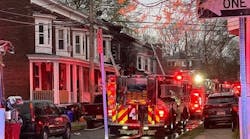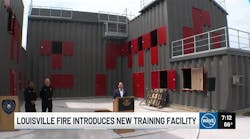My career in the fire service started comparatively late (at age 28) while also being a seven-year veteran of the U.S. Army. My first impressions of the volunteer fire service started in Germany as a member of the Freiwillige Feuerwehr (Volunteer Fire Department) Troesel in Hessen in a basic engine company. I trained in all of the basics and graduated from the state primary officers academy.
I am now a 15-year veteran of the volunteer fire service and a 23-year veteran of the Army. What has struck me most about the challenges of the volunteer fire service is not so much that we train technically proficient firefighters, but that there is no definitive roadmap for how we develop leaders. I would like to share some thoughts that may help guide the development of junior volunteer fire service leaders and that I compiled for a leadership class I conducted in conjunction with the chief officers at Carlisle, PA, Fire and Rescue Services.
As the fire service is considered a paramilitary organization, it was easy to tie the class into both military and firematic themes. Some of the challenges we discussed are that leadership is also developed through life experience. Key events such as marriage, divorce, the birth of a child, having a career outside of the fire service and paying a mortgage are things that just don’t come out of a book, but are key and critical to the development of the new officer. The following themes are geared toward newly appointed company and chief officers.
Military Themes
• Mission first, people always – This is not only a mantra of the U.S. Army, it’s what we are all about. The mission, and its accomplishment, always remain in the forefront of every unit member’s mind. The critical step is for the leader to be able to take into consideration the human factors required to lead people to accomplish that mission. Even though it may be a volunteer army, soldiers are bonded by oath to follow their leaders (or the officers appointed over them under the Uniform Code of Military Justice).
For a brand-new officer in the volunteer fire service, this is an even greater challenge because it is just that, a volunteer organization. The leadership challenge is to make the team want to accomplish whatever task is put before them and, more importantly, make them want to come back for more.
By knowing the strengths and weaknesses of team members, the new officer can develop a plan that will accomplish the mission; frequently, we follow standard operating guidelines (SOGs). While this may work in a career department, where manpower is usually predictable, in the volunteer fire service teams vary greatly based on time of day, day of the week or even which game animal happens to be “in season” that month. The bottom line is that officers must know all of their people, know their strengths and weaknesses and be able to apply them in any given situation.
The same can be said for Army Reserve components upon mobilization. I have served with the Army Reserve for the past 19 years, and every time a unit arrives at its mobilization station, it frequently looks like staging at a major incident, where the staging officer must weed through the masses to eventually put them into cohesive teams. Once the leader knows his or her people, they can grow together, and with what the commander provides as intent, each team member places the mission (and its accomplishment) first and foremost in their minds. Bottom line, know your people.
• Task/condition/standard – Everything that is accomplished in the military follows this model. If there is a task to be accomplished, it will be performed under certain conditions and there is an acceptable standard. The Army codifies its standards through regulations, as much as the fire service codifies its performance through established standards, such as National Fire Protection Association (NFPA) standards or even departmental SOGs.
A firematic example would be as simple as the first-arriving engine company responding to a dwelling fire receives the command, “Engine 249, take a line to the second floor, get a ‘knock’ on the fire.” This simple command has a task (take a line to the second floor), condition (given a structure fire at whatever time of day, a Class A pumper with a full crew and an adequate water supply; the implied task here is that they are resourced for the mission at hand) and standard (find the seat of the fire with an implied task of getting it done now). What is more difficult, especially to the new company officer, is in situations other than those governed by SOGs.
Fire Service Themes
• Be specific about your expectations – Frequently in the volunteer fire service, there are a multitude of scenarios that happen, often without SOGs. One of these tasks might be as simple as setting up for a community day. An officer is usually in charge of things like this, as the “community events guy.” On days such as this, he’s probably a very busy person, so he gives some guidance in between meetings that usually happen at exactly the same time as things need to be set up, and his guidance is usually “do it like we’ve always done it.”
The problem is that many in his team have been in the organization for less than a year, and he comes back to less-than-optimal results. He didn’t happen to mention to the team that the first-due engine would be placed out of service in order to make a static display with all equipment out of the compartments and the compartments open and that the second-due engine needed to have its thermal imaging camera and the rapid intervention team (RIT) bag transferred. In short, a great “plan” turns into a debacle.
In the Army, I frequently heard my company commanders or junior staff officers rage about how the units “just don’t get it.” They were very specific (to other members of the staff) about how the operation would run, but the response and results were lackluster at best at the company level. I would always ask the young officer, “What did you ask them to do, specifically?” The usual answer would be, “Well, they know what I mean” or “You know, like we did it last year.”
The simple failure to provide intent and a definitive task/condition/standard led to mission failure. From the volunteer fire service perspective, the team may not feel like a team, and depending on human factors (lack of trust or pride), may even seek free agency with another department. Bottom line, be specific about your expectations and monitor their progress.
• The one-third/two-thirds rule – Some may think this is a complex math problem from hydraulics, but it actually boils down to one thing: respect for time, and in a volunteer fire organization, everything is about time. Basically, if you have three hours to get a mission accomplished, the supervisor should take no more than one hour, one-third of the time available, and then allow those under their command two hours to complete a task. Obviously, for a bread-and-butter house fire (which usually takes about three hours until the hoses are rolled up) the incident commander would not take a full hour to get a plan together; however, in other circumstances, an hour of planning may be required.
• Respect their time – Another example of recurring jobs that volunteer fire companies do is prepare for events, such as a banquet. There is usually one person “in charge,” and unfortunately once the manpower arrives to accomplish the detail (as is always a dimension in the volunteer fire service), the planner should have no more than one hour to accomplish developing the plan and allow two hours for the unit to set up the hall. But here is where another leader teaching point occurs. That hour that was for planning must occur prior to the arrival of the manpower. In the Army we call that “leader time,” meaning the time that you as a leader need in order to properly plan before you go in front of the troops so the plan is solid and their time is not wasted. As a volunteer organization, waste people’s time with regularity and it will be hard to get them to come back. Respect their time and have a plan.
When you assume the role of a leader, the challenge is that, even if you have all of your fire and officer series certifications, it still does not teach you the things that are critical in leader development, including compassion, maturity and, most importantly, common sense. The military, like the volunteer fire service, is more of a calling than a career. The lifelong learning that accompanies our chosen calling makes it all the more satisfying for those we serve to protect, and for those we continue to develop to one day take our place.
The great baseball player Roberto Clemente put it best when he said, “Any time you have an opportunity to make a difference in this world and you don’t, then you are wasting your time on earth.” May we all make the best of our time to develop that next generation. They deserve nothing less





